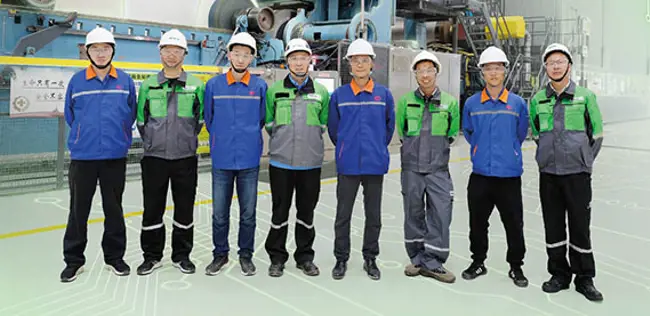Predicting the future using data
Dec 12, 2019
Instead of typical production planning and control, data-driven applications incorporating artificial intelligence (AI) help us take a more holistic view of the entire chain of production by utilizing data from several sources. While Industrial Internet applications can be used to instantly optimize processes, they also allow us to predict what’s around the corner.

“Tomorrow’s successful companies will increasingly base their decision making on insights from predictive applications with artificial intelligence,” emphasizes Jari Almi, Vice President, Industrial Internet at Valmet.
“In practice, this means, thanks to AI-based applications and machine learning, it will be possible to predict upcoming variations and incidents, make decisions based on predicted events and act proactively. This approach is valid for production, maintenance and business too,” he explains.
Simply put, the benefit of advanced analytics is that it can recognize repeating patterns or a chain of events in large data volumes leading to a certain incident in the future. By recognizing these patterns, it can predict when the same incident is likely to reoccur and alert the user in advance. In future, artificial intelligence will likely also replace the operator and fill the best setpoints automatically in the system.
Toward more autonomous operations
“Thanks to the more predictive nature of the available information, it’s possible to gain better control of the daily work in a mill or plant by pre-planning activities and running the process with fewer resources. This is a fundamental change and will lead to a more autonomous mill or plant.”
“Nowadays, operators run machines based mostly on historical data and their experience of the best running parameters and setpoints. A lot of real-time data is available from the automation system, but data use is mostly limited to controlling the process. This is because it’s impossible for a human to analyze thousands of data points at the same time and recognize repeating patterns in them. In the future mill or plant, it will be possible to manage and optimize mill-wide operations through data-driven applications by combining and analyzing data from various sources,” says Almi.
Utilizing data from several sources
In practice, there are several useful data sources across mill operations and the entire value chain: a machine and process automation system with a lot of data from the equipment and production, quality data from the laboratory, maintenance management systems and business data, including Enterprise Resource Planning and Manufacturing Execution Systems.
The machine and process automation systems are a key data source. Combining this data with maintenance and business data will provide a new dimension to make machines more intelligent.
“At Valmet, we’re looking for ways to connect Valmet machinery, systems and fleets equipped with advanced sensors, controls and software applications. Combining the data with our process and machinery knowhow will enable us to leverage the embedded intelligence in the main process equipment for more predictable and autonomous operations,” explains Almi.
This embedded intelligence will provide a more detailed status for each piece of equipment, and its need for maintenance and spare parts. “We want to reduce unplanned downtime and optimize maintenance. For example, when we can predict upcoming machine failures early enough, the maintenance team can proactively plan the required actions before the next shutdown. Preventing equipment failures happening brings real business value to customers.”
This allows a move from scheduled equipment maintenance to outcome-based maintenance.
“Based on prescriptive analytics, the system can indicate how to run or modify the machine to ensure it’s safe to extend operations until the next planned maintenance break. Our future vision is for the system to autonomously recover from detected problems by changing its own settings to adapt to the predicted problem.”
A holistic view of the entire production chain
The key aim of big data analysis and related AI-driven applications is to learn from historical data and to take all interactions better into account, even within a single process area or throughout the wider horizontal value chain. Instead of the traditional approach of adjusting and optimizing the mill mainly at the process area level, the target is to understand and manage the production system as a whole.
“For instance, in an ideal situation, we combine data from pulp mill, paper machine and converting processes and apply a mill-wide operational control solution, enabling the customer to optimize manufacturing costs, product quality and productivity across the mill,” says Almi.
“Industrial Internet applications allow us to predict what’s around the corner.”
“Thanks to new technology, we can model the mill’s entire production chain and optimize it accordingly. When orders are available in the production planning system, we know what kind of final product should result from the process at each moment and can cascade the best setpoints to all upstream process areas, based on the final product specification.”
“By combining and utilizing data from several mill systems, it’s possible to identify the most profitable way of turning incoming raw material into final sellable products,” Almi explains.
How to get started
The best approach to seeking value from the data and getting development started is to initiate a data discovery process utilizing a batch of historical data, e.g. from the mill information management system. Data discovery makes it possible to find a root cause of an identified problem or to take a more holistic approach to finding improvement potential in the production process by utilizing historical data. Typically, data discovery takes six to eight weeks, and engages Valmet’s data scientists and process specialists in collaborating with the customer’s specialists to get everything out of the data. The outcome of data discovery is not only limited to a final report; typically, a data-driven advisory application is also created during the process to address the discovered improvement opportunity.
“Data discovery helps customers to understand the root cause of the identified issue or to take a holistic approach to the process area or mill improvement, relying on big data historical analysis. Understanding the root cause and chain of events leading to a certain incident from the data enables us to develop an advanced algorithm to recognize and predict the same issue from online data,” Almi explains.

“Thanks to the more predictive nature of the available information, it’s possible to gain better control of the daily work in a mill or plant by pre-planning activities and running the process with fewer resources. This is a fundamental change and will lead to a more autonomous mill or plant,” says Almi.
Valmet also uses accumulated historical data to verify the feasibility of the selected advisory or predictive applications for the customer’s process. Verifying application usability with a batch of historical data allows fast and risk-free implementation of data-driven applications for both parties. Once this is verified and the results are agreed, it’s time to move into the continuous service phase by implementing data connectivity and making online applications. The final step is therefore to incorporate the application in the customer’s daily operations to support performance and reliability development.
“We’ve been digitalizing our customers’ production processes for the last few decades. Now it’s time to take another step and leverage data from digitalized processes for the digital transformation of processes and businesses. In our experience, change management plays a key role when companies are adopting new data-driven applications incorporating artificial intelligence. While digitization is technology-driven, converting analog systems into digital systems, digitalization is more about utilizing the data and the latest technology to make processes more efficient and enable new business models. So there’s always a human perspective connected with digitalization. If new advisory applications and other technology enablers are not integrated properly with daily operations and processes, it’s impossible to achieve the desired level of value from the change.”
Almi notes that the move to a more autonomous mill will highlight the importance of operators’ capabilities instead of abandoning them.
“Operators must be able to understand how the whole system works, because they’ll have more extensive tools at their disposal. They’ll be more responsible for reliability, performance and the quality optimization of the production processes than they used to be. It’s also predicted that the recent developments and digitalization will enable a gradual shift from a traditional line organization to a real process management model.”
Predictability increases efficiency
All told, artificial intelligence will play a major role in the future mill or plant, but it will be a long time before it replaces the role of experts. The best results can be achieved by engaging people working with the new technology through an agile development approach. Instead of multi-year development projects trying to solve all the issues at once, new opportunities should be explored step-by-step and by learning on the go to achieve the vision of the more autonomous mill of the future.
“Ultimately, empowering our customers to move toward an autonomous plant or mill will result in significantly more efficient production processes. Mills and plants will be able to operate more cost-effectively, decrease their use of raw materials and boost output at the process and plant levels. The ultimate goal is that data-driven applications incorporating artificial intelligence will converge with process automation and other mill control systems, and take over controlling setpoints for the optimization of manufacturing costs, product quality and productivity mill-wide,” Almi concludes.
TEXT Vesa Puoskari
PHOTOS Tomi Parkkonen
Article published in Forward magazine 3/2019.
Related content







